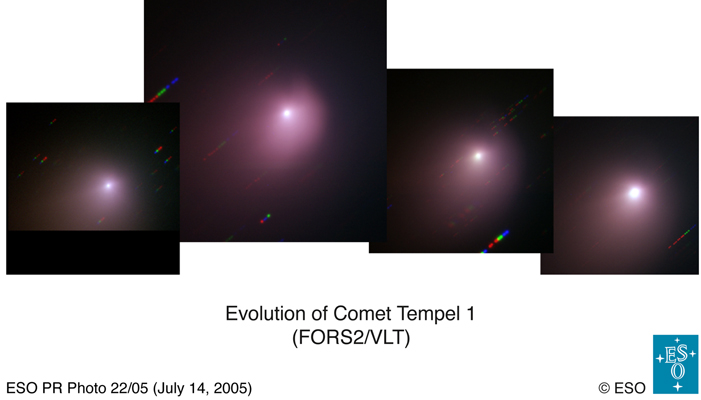Of the many things demonstrated by the Deep Impact mission to comet Tempel 1, the evolution of astronomy is not the least significant. Gone are the days of the isolated mountain-top observer painstakingly examining photographic plates whose findings might be corroborated only weeks or months later by other astronomers. During the Deep Impact mission, the European Southern Observatory used every modern communications tool in the book as part of a collaboration between all major observatories worldwide.
The result: round the clock data through a wide variety of instruments both Earth and space-based, making Deep Impact a hugely successful example of distributed astronomy — ‘distributed’ as in ‘distributed computing,’ where powerful resources share their capabilities to produce a result far greater than any one of them could achieve.
 From all this, we know that Tempel 1 was not significantly transformed by the Deep Impact collision. In fact, the impactor evidently did not create a large outflow of subsurface material, as had been hoped for and anticipated. ESO’s La Silla Paranal Observatory shows that the initial plume of material, ejected at speeds of from 700 to 1000 kilometers per hour, quickly became diluted and less visible. Adaptive optics aboard ESO’s Very Large Telescope showed the same jets of material were active as before the impact.
From all this, we know that Tempel 1 was not significantly transformed by the Deep Impact collision. In fact, the impactor evidently did not create a large outflow of subsurface material, as had been hoped for and anticipated. ESO’s La Silla Paranal Observatory shows that the initial plume of material, ejected at speeds of from 700 to 1000 kilometers per hour, quickly became diluted and less visible. Adaptive optics aboard ESO’s Very Large Telescope showed the same jets of material were active as before the impact.
Image (click to enlarge): The evolution of comet Tempel 1 after the Deep Impact collision as observed with the FORS2 instrument on Antu (VLT) at La Silla.
Other notes: a new active region detected by ESO’s data is not correlated with the impact, as it shows up in data collected in June (before Deep Impact’s arrival). The region appears every 41 hours, coinciding with the rotation period of the cometary nucleus. Ahead are exacting measurements of the chemical composition of the material released by the collision as well as from the newly identified region. All told, Tempel 1’s dust does not appear to be coming from beneath the surface.
Asked whether he was disappointed by the lack of post-impact activity on Tempel 1, Olivier Hainaut, the head of Paranal Science Operations, had this to say:
I can assure you that at the ESO La Silla Paranal Observatory, and at the ESO Offices in Santiago, there has been -and still is- a LOT of activity! Concerning the comet itself, the fact that the comet does not seem to show long-term effects is a result, and a very interesting one. It will be easier to analyze once we have more details about the crater, but in the meantime, it is really interesting to see that the comet is recovering that fast.
The rest of the Hainaut interview can be read here, and ESO’s news release on the latest Tempel 1 findings is also available.

